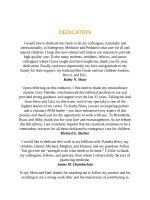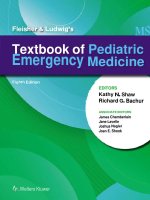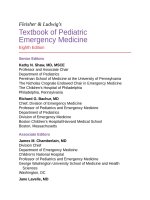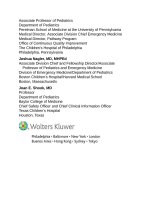Pediatric emergency medicine trisk 843
Bạn đang xem bản rút gọn của tài liệu. Xem và tải ngay bản đầy đủ của tài liệu tại đây (139.54 KB, 4 trang )
Triage Considerations
Children with minor trauma should be assessed for associated significant injuries.
Injuries that compromise airway, breathing, or circulation (systemically or locally,
such as in a limb) require immediate attention.
Wound management should not preempt care of more life-threatening injuries.
If there are no significant injuries, the focus should move to addressing
hemostasis and pain control. Application of topical anesthetics and administration
of oral analgesics can be initiated at triage. Once these measures have been
initiated, the emergency provider should aim for appropriate and timely wound
repair.
Clinical Assessment
History. In the evaluation of a laceration, it is important to understand the
mechanism of the injury because this has a direct impact on management plans.
For instance, if the wound was caused by an animal bite, the likelihood of
infection and devitalized tissue is higher, thus wound closure may be avoided and
healing by secondary intention may be preferred in selected areas (Chapter 94
Infectious Disease Emergencies ). Similarly, a wound caused by a blunt object
may be associated with an underlying fracture or crush injury. These injuries are
inherently more complicated and may require surgical consultation and hospital
admission. A wound caused by a sharp or projectile object may cause deeper
tissue or vascular injury. It is also important to determine the age of the wound, as
well as the possibility of a foreign body in the wound, since these factors also
need to be considered in the management of the wound.
TABLE 110.1
TETANUS PROPHYLAXIS
Prior tetanus
toxoid
immunization
(doses)
Clean minor wound
Uncertain (or less Tetanus toxoid–containing
than 3)
vaccine a
Three or more
Td
(most recent
more than 10 yrs
ago)
Three or more
None
(most recent
between 5 and
10 yrs)
All other wounds
Tetanus toxoid–containing
vaccine and TIG or TAT
Td
Td
a If
the child is <7 yrs, give DTap. If the child is 7–11 yrs and is underimmunized, give Tdap. If the child has
already had a dose of Tdap between 7 and 11 yrs, revaccination is not required at 11 yrs.
TIG, tetanus immunoglobulin (dose: 250–500 units IM); TAT, tetanus antitoxin—should be used only if TIG
is not available and after testing (dose: 3,000–5,000 units intramuscularly); Td, adult formulation of
diphtheria, tetanus toxoid.
The emergency provider should consider the location of the wound. If the
wound is in the neck area, there may be possible extension through the platysma
muscle, with potential for a serious injury to underlying structures. If the wound
involves the chest, the clinician should feel for crepitus in the subcutaneous
tissue, suggesting injury to the underlying lung. An injury to the lower extremities
is more likely to result in infection because of the relatively poor blood supply.
Likewise, a wound overlying a joint space can be complicated if the joint cavity
is violated. Injury to distal body parts such as the ears, nose, and fingers may
threaten the viability of more distal tissues secondary to vascular compromise.
Conversely, in areas where the vascular supply is robust, such as the face, scalp,
and tongue, the infection rate is low regardless of the mechanism of injury.
Assess the environment in which the injury occurred. If the injury occurred on
the street, it is possible that small particulate matter may be embedded in the
wound. If this debris is left in place, tattooing of the skin could result, leaving an
unfavorable appearance to the healed wound. Injuries that occurred in a field,
farm, or a wet, swampy area may have high bacterial loads.
The patient’s health status and past medical history should be addressed to
determine if there are additional risk factors for poor healing. If the patient has
diabetes, immunosuppression, malnutrition, or other chronic conditions, such as
cyanotic heart disease, chronic respiratory problems, or renal insufficiency, higher
infection rates may be anticipated. Bleeding disorders and current medications
should be determined because some drugs, such as corticosteroids, may also have
an impact on wound healing. A history of allergies to latex, antibiotics, and local
anesthetics, as well as the child’s tetanus status should be determined.
Physical Examination. A careful physical examination is essential before giving
local anesthesia. First, determine whether there is an associated injury distant
from the obvious wound. It is important to assess the wound for vascular damage
and to control bleeding if present. Brisk flow of blood may indicate injury to a
major vessel. This vessel can usually be safely tamponaded and later ligated or
sutured. The source must be identified, although it is often obscured by profuse
bleeding. Pressure applied to the site or temporary use of a tourniquet or inflated
blood pressure cuff (less than 2 hours) can help control hemorrhage and allow for
identification of the bleeding vessel. Blind clamping of an artery should be
avoided except in the scalp. Palpation of pulses and capillary refill distal to the
site of injury must be checked.
Next, potential nerve damage must be assessed. For example, in a cooperative
child, the provider should always test the median and ulnar nerves of an injured
upper extremity. If a young child does not permit this, sensation may be tested
with use of pinprick. Fortunately, when sensation is intact, motor function of the
nerve is usually also intact.
Next, the wound must be evaluated for possible tendon injury. The superficial
location of extensor tendons of the dorsum of the hand predisposes them to injury.
Tendon injuries are sometimes visible if the wound is wide and deep. For
example, a torn tendon on the flexor surface of the forearm may be seen when the
patient with a laceration to the wrist is asked to flex the hand and wrist. Unless
the tendon injury is obvious, wounds over joints and tendons should be put
through a full range of motion. A young patient may not be cooperative enough to
flex and extend the fingers on command. Therefore, it is important to inspect the
resting position of the injured hand in a young child to note a flexor tendon injury
to the finger. One digit may be found extended at rest, while the other uninjured
digits are flexed ( Fig. 110.1 ). Applying a noxious stimulus and noting inability
to withdraw the finger that is tested may show injury to the extensor tendons.
Role of Imaging. If the history or physical examination raises concern for
possible foreign material in the wound, consider obtaining a radiograph or an
ultrasound. This is especially important in assessing a wound caused by glass. A
deeply embedded piece of glass may be missed without radiographs or
ultrasound. Some recommend obtaining plain radiographs in all cases in which
glass is involved, except for the most superficial wounds. Ultrasound is more
sensitive in detecting and localizing foreign bodies and can identify those that are
nonradiopaque, such as plastic and wood, which will not be seen on plain films. It
is a good idea to further inspect for foreign material after the wound is
anesthetized, as well as counsel families that retained foreign body is a possible
complication.
Finally, bones nearby the wound should be palpated for crepitus, tenderness, or
deformity, which may suggest a fracture. Obtain radiographs to confirm
suspicious findings. Wounds overlying a fracture may constitute an open fracture
and deserve consultation with an orthopedic surgeon for possible management in
the operating room. Table 110.2 summarizes general principles of wound
assessment.









